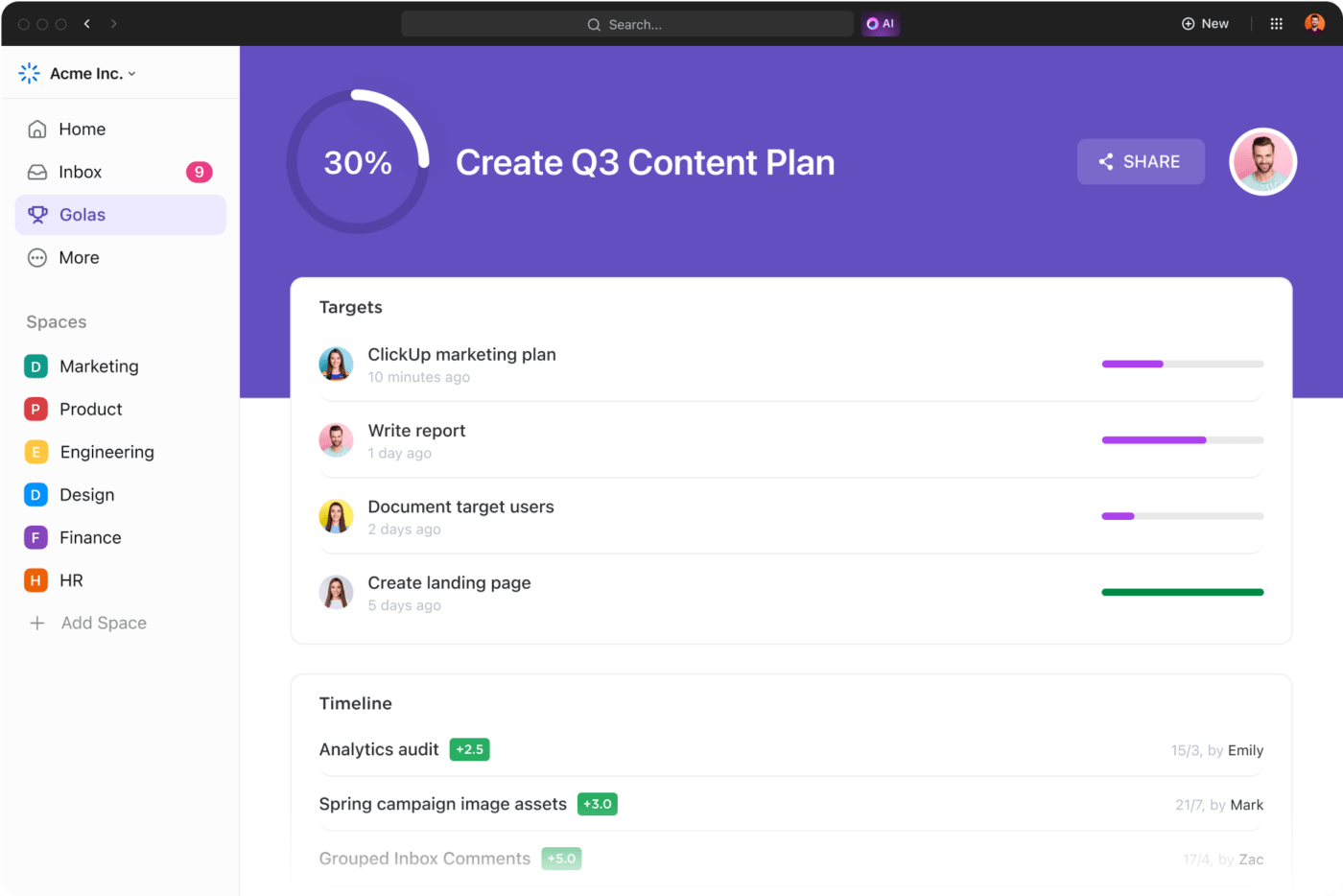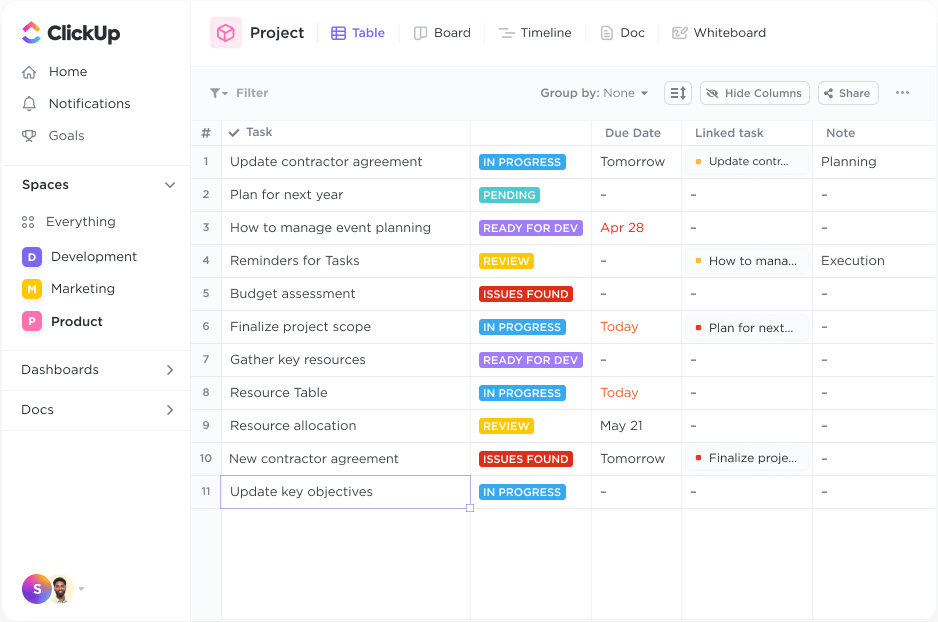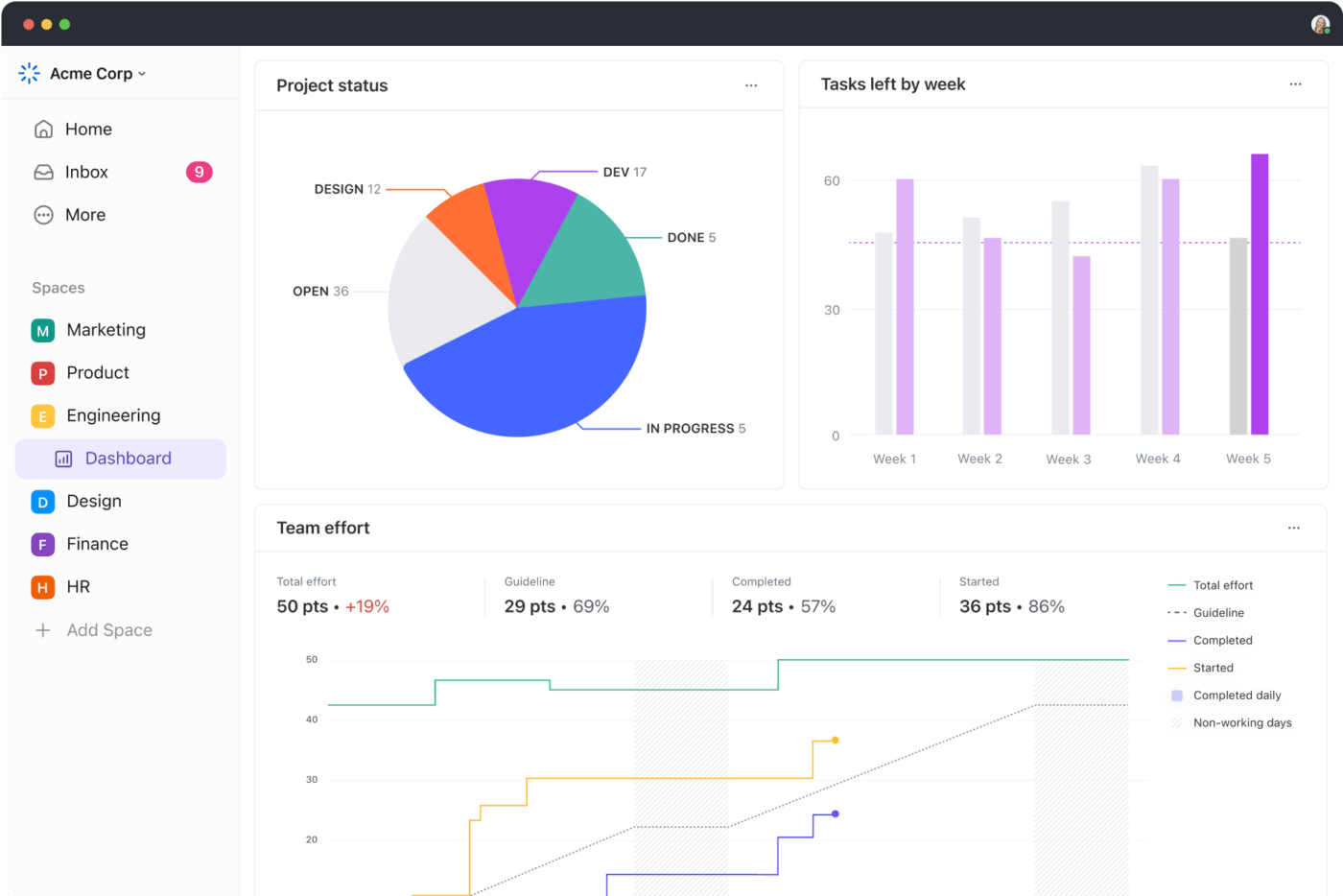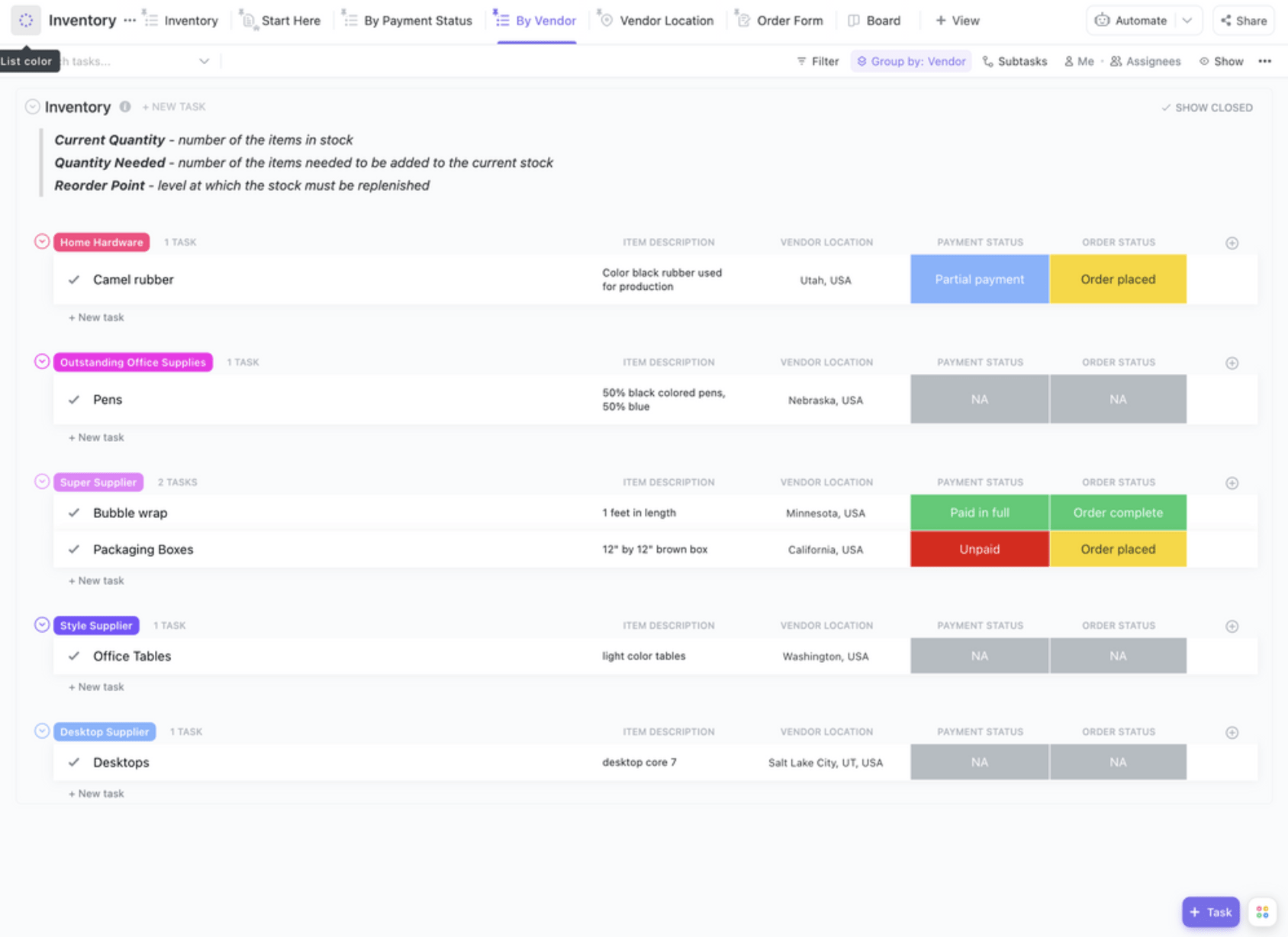تعتمد كل شركة، سواء كانت كبيرة أو صغيرة، على الأنظمة والعمليات من أجل العمل بسلاسة.
إحدى هذه العمليات الهامة هي إدارة المخزون. إن ضمان توفر المنتجات عند ارتفاع الطلب أمر ضروري للحفاظ على زخم المبيعات.
تؤدي الإدارة الفعالة للمخزون إلى توفير التكاليف وضمان سلاسة العمليات. لذلك لا عجب أن الشركات تستثمر بشكل متزايد في أنظمة إدارة المخزون. في الواقع، من المتوقع أن ينمو سوق هذه التقنيات بمعدل مركب معدل نمو سنوي قدره 9.7% ليصل إلى 4.84 مليار دولار بحلول عام 2032.
لذا، تابع القراءة لتتعلم كيفية إنشاء نظام إدارة المخزون الذي يمكن أن يساعد شركتك على البقاء في الطليعة وتلبية طلبات العملاء بثقة.
ما هو نظام إدارة المخزون؟
إدارة المخزون أمر بالغ الأهمية لتتبع تدفق المنتجات من الموردين إلى المستودعات ثم إلى العملاء. ويتمثل هدفها الرئيسي في ضمان وجود العناصر المناسبة في المكان المناسب في الوقت المناسب.
يُظهر نظام إدارة المخزون المخطط له جيدًا عناصر المخزون في سلسلة التوريد الخاصة بك ويساعدك على معرفة وقت إعادة تخزينها.
بالنسبة للشركات ذات قنوات البيع المتعددة، فإن فعالية برنامج إدارة الطلبات يوفر رؤية دقيقة لعمليات التنفيذ والمخزون عبر جميع القنوات.
على سبيل المثال، يجب أن يتتبع النظام الخاص بك حالة المخزون وتحديثه مرة واحدة في كل ملاحظة استلام البضائع موقعة. وهذا يضمن الدقة في العمليات المحاسبية النهائية.
فيما يلي العديد من الأسباب الرئيسية التي تجعل نظام إدارة المخزون المهيكل ضروريًا للأعمال التجارية:
1. يحسن الإدارة المالية
تساعد إدارة المخزون على منع الانسداد غير الضروري لرأس المال العامل من خلال تتبع المخزون وتسليط الضوء على المنتجات التي تباع بسرعة أو ببطء. يتيح لك ذلك إعطاء الأولوية للعناصر ذات الربح المرتفع وتعديل مستويات المخزون للمنتجات بطيئة الحركة.
2. يعزز رضا العملاء
يمكن أن يؤدي سوء تنظيم المخزون إلى بطء عمليات التسليم وإحباط العملاء. تعمل الإدارة الفعالة للمخزون على تسريع عملية الشحن من خلال تبسيط عملية تخزين العناصر وحركتها، مما يقلل من مخاطر إلغاء الطلبات أو نفاذ المخزون الذي يخيب آمال العملاء.
متقدم برنامج إدارة المخزون يوفر رؤية كاملة لموقع كل عنصر وحركته. وهذا أمر بالغ الأهمية للتوزيع الفعال، خاصةً للشركات ذات المواقع المتعددة.
3. يعزز الأتمتة والتحليلات
تسمح الأدوات المؤتمتة بالتتبع والتحليل المنهجي لبيانات المخزون. تجمع برامج إدارة المخزون معلومات في الوقت الفعلي عن مستويات المخزون ومعدلات الحركة وغير ذلك. تكشف هذه البيانات عن أنماط المبيعات، وتحدد مجالات التحسين، وتساعد على أتمتة العمليات مثل تقدير أوقات الشحن.
بالإضافة إلى ذلك, موارد إدارة المشاريع يمكن أن تعزز هذه التحسينات من خلال تخصيص المهام بفعالية ومراقبة التقدم المحرز، مما يضمن تشغيل نظام المخزون الخاص بك بكفاءة.
4. يحسن تنظيم المخزون
تعتمد سرعة تنفيذ الطلبات ورضا العملاء على مدى سرعة الموظفين في العثور على العناصر وشحنها. من خلال تنظيم المخزون وإدارته بفعالية، يمكنك تحديد العناصر الشائعة والمنتجات التي يتم إقرانها بشكل متكرر والمنتجات ذات معدل الدوران البطيء وترتيب المخزون بشكل أكثر كفاءة.
كيفية إنشاء نظام إدارة المخزون: عملية خطوة بخطوة
يمكن للإدارة الفعالة للمخزون أن تؤثر بشكل كبير على عملك، خاصةً إذا كنت تقوم بتوسيع نطاق عملك.
إليك عملية خطوة بخطوة لإنشاء نظام قوي لإدارة المخزون:
1. التخطيط والإعداد
يمكن أن يكون تصميم وتطوير حتى نظام إدارة المخزون البسيط أمراً معقداً، لذا فإن التخطيط والتحضير الشاملين ضروريان. ضع في اعتبارك العوامل الرئيسية التالية:
- عمليات التكامل: تحديد الأنظمة التي تحتاج إلى الاتصال مع تطبيق إدارة المخزون الخاص بك، مثلتخطيط موارد المؤسسات، وإدارة علاقات العملاءو WMS (أنظمة إدارة المستودعات)، وبرامج المحاسبة، وإدارة أوامر الشراء، وأنظمة نقاط البيع. يساعد نظام إدارة المستودعات WMS على وجه التحديد من خلال تحسين عمليات المستودعات، وتحسين تتبع المخزون وتقارير المخزون، وضمان تنفيذ الطلبات بدقة
- نوع النظام: حدد ما إذا كنت بحاجة إلى نظام قائم على البرمجيات فقط أو نظام يتضمن مكونات الأجهزة
- ترحيل البيانات: التخطيط لكيفية نقل البيانات من سجلات المخزون الثابتة الحالية إلى قاعدة بيانات ديناميكية
💡 نصيحة احترافية: استخدم انقر فوق اللوحات البيضاء لتحويل أفكار فريقك إلى خطط عمل مفصلة في مساحة واحدة منظمة. فهي تتيح التعاون في الوقت الفعلي وتصور المهام، مما يسهل تعيين المسؤوليات وتتبع التقدم المحرز والحفاظ على توافق الجميع.
2. تحديد أهدافك ومتطلباتك
تتضمن الخطوة الثانية تحديد أهداف ومتطلبات نظام إدارة المخزون الخاص بك. ابدأ بتحديد الميزات الأساسية التي يجب أن يدعمها نظامك. على سبيل المثال، إذا كانت نقطة البيع الخاصة بك تستخدم تقنية RFID، فيجب أن يكون نظام إدارة المخزون الخاص بك متوافقاً مع هذه الطريقة لتسجيل المبيعات.
حدد الميزات غير القابلة للتفاوض التي تحتاجها، مثل تكامل عمليات المبيعات والعمليات أو تنبيهات المخزون الآلية. تأكد من توافق هذه المتطلبات مع أهداف عملك.
على سبيل المثال، إذا كان الحد من الإفراط في التخزين خلال مواسم ذروة المبيعات يمثل أولوية، فيجب أن تكون قدرات التنبؤ القوية بالمخزون من المتطلبات الأساسية. من خلال تحديد المتطلبات بوضوح، فإنك تضمن أن النظام الذي تطبقه سوف يلبي احتياجات عملك بفعالية ويدعم أهدافك الاستراتيجية.

تحديد أهداف قابلة للقياس بفعالية وتتبع التقدم المحرز باستخدام ClickUp Goals أهداف ClickUp Goals يساعدك على الاستمرار في التركيز على تحقيق أهدافك من خلال جداول زمنية واضحة، وأهداف قابلة للقياس، وتتبع التقدم التلقائي.
عند إعداد نظام إدارة المخزون الخاص بك، يمكن لـ ClickUp Goals تبسيط العملية من خلال السماح لك بتحديد أهداف محددة - سواء كانت رقمية أو نقدية أو صحيحة/خطأ أو قائمة على المهام - تتماشى مع احتياجاتك، مثل تحسين دقة المخزون أو تحقيق أهداف المبيعات.
ومن خلال تحديثات التقدم التلقائية والجداول الزمنية المحددة جيدًا، تضمن لك ClickUp Goals البقاء على المسار الصحيح، ومواءمة إعداد نظام إدارة المخزون مع الأولويات الاستراتيجية وتعزيز الكفاءة العامة.
3. إجراء أبحاث السوق
بعد تحديد متطلباتك وأهدافك، تتمثل الخطوة الثالثة في إجراء أبحاث السوق لتحديد البرامج والأدوات المتاحة. ركز على أكثر أنظمة إدارة المخزون شيوعًا التي تستخدمها الشركات المشابهة لشركتك من حيث الحجم.
أثناء البحث، ضع في اعتبارك ما إذا كانت هناك برامج أو أدوات إضافية، مثل المشتريات أو البرامج اللوجستية، قد تكون ضرورية لتعزيز قدرات نظامك. قارن بين الخيارات المختلفة، بما في ذلك تكاليف التعاقد مع المطورين مقابل استخدام الحلول المبنية مسبقاً، لتحديد الخيار الأكثر فعالية من حيث التكلفة والأنسب لاحتياجاتك.
💡 نصيحة احترافية: قم بتنظيم المعلومات التي تجمعها في هيكل عرض الجدول في ClickUp . أنشئ جداول منفصلة وأضف حقولاً مخصصة لتقييم الميزات الرئيسية والتسعير وخيارات التكامل لأنظمة إدارة المخزون المختلفة. بهذه الطريقة، يمكنك تحليل ومقارنة الخيارات بكفاءة لتحديد الحل الأنسب والأكثر فعالية من حيث التكلفة لاحتياجات عملك.
4. تصميم النظام
تصميم النظام هو مرحلة حاسمة في تطوير نظام إدارة المخزون. في هذه المرحلة، ستعمل مع فريق التطوير الخاص بك لتخطيط وتصميم الوحدات والمكونات والواجهات والتفاعلات التي ستشكل نظامك.
ابدأ بتصميم عالي المستوى لتوضيح الهيكل العام للنظام وتدفقه، يليه تصميم أكثر تفصيلاً على مستوى منخفض يتناول وظائف ومكونات محددة. سيقوم المطورون لديك بصياغة هذه التصاميم وإنشاء بنية مناسبة باستخدام أدوات مثل المخططات الانسيابية ومخططات UML والإطارات السلكية. في هذه الملاحظة، استخدم ClickUp Mind Maps لتحديد الهيكل الأساسي لنظامك والتوسع في التفاصيل. سيساعدك ذلك على تصور وتنظيم عملية التصميم، مما يضمن لك بنية نظام شاملة ومتسقة.
نصيحة إضافية: استخدم قوالب المخزون لتسريع تصميم وإعداد نظامك. بهذه الطريقة، يمكنك بسرعة تنفيذ هيكل وظيفي مصمم خصيصًا لاحتياجاتك دون البدء من الصفر.
5. الهندسة المعمارية والتصميم
تعتبر مرحلة الهندسة المعمارية والتصميم حاسمة لإنشاء أساس قوي لنظام إدارة المخزون الخاص بك (IMS). تتضمن هذه الخطوة تحديد الهيكل العام لنظامك ومكوناته، والتي عادةً ما تتبع نموذج العميل-الخادم.
تتكون البنية من عدة مكونات رئيسية:
- قاعدة البيانات: تعتبر قاعدة البيانات العمود الفقري لنظام إدارة المخزون الخاص بك، حيث تقوم قاعدة البيانات بتخزين معلومات المنتج الهامة مثل وحدات حفظ المخزون والأسماء والأوصاف والكميات والمواقع والأسعار. يضمن هذا المستودع المركزي اتساق البيانات وسهولة الوصول إليها عبر النظام
- منطق الأعمال: يتعامل هذا المكون مع الوظائف الأساسية للنظام، بما في ذلك الحسابات على مستوى المخزون ومعالجة الطلبات والتنبؤ بالطلب. ويضمن أن يعمل النظام بكفاءة ودقة وفقًا للقواعد والعمليات المحددة
- طبقة التكامل: تعمل هذه الطبقة على تسهيل الاتصال بين نظام إدارة المعلومات والأنظمة الأخرى، مثل أنظمة نقاط البيع (POS) وبرامج تخطيط موارد المؤسسات (ERP) وأنظمة الشحن وأدوات إدارة الطلبات. وهي تتيح تبادل البيانات وتكاملها بسلاسة عبر التطبيقات المختلفة
- واجهة المستخدم (UI): توفر واجهة المستخدم واجهة سهلة الاستخدام للتفاعل مع النظام. تتيح للمستخدمين إدخال البيانات واسترجاعها وتحليلها بكفاءة، مما يضمن تجربة مستخدم سلسة وبديهية
- وحدة إعداد التقارير: يُنشئ هذا المكون تقارير أساسية عن معدل دوران المخزون وتحليل المبيعات ومستويات المخزون وغيرها من المقاييس الحيوية. وهو يساعد في تتبع الأداء واتخاذ القرارات المستندة إلى البيانات
من خلال تصميم كل مكون بعناية، يمكنك إنشاء نظام إدارة مخزون جيد التنظيم يلبي احتياجات عملك ويدعم عمليات إدارة المخزون الفعالة.
6. اختيار حزمة التكنولوجيا المناسبة
بمجرد إنشاء هيكلية نظام إدارة المخزون الخاص بك، فإن الخطوة التالية هي اختيار حزمة التكنولوجيا التي توفر الأدوات والأطر اللازمة لبناء البرنامج وتشغيله. ستمكن هذه الحزمة التقنية المطورين من إنشاء نظام يتوافق مع متطلباتك وأهدافك.
ابدأ باختيار لغات البرمجة التي سيتم استخدامها، مثل PHP أو Swift أو Python أو غيرها، بناءً على احتياجات النظام وخبرة فريقك.
بعد ذلك، حدد قواعد البيانات والأنظمة الأساسية والأطر المناسبة التي ستدعم وظائف النظام وقابليته للتوسع. بالإضافة إلى ذلك، حدد المكتبات ذات الصلة لتعزيز عملية التطوير وإضافة الميزات الضرورية.
عند اختيار الحزمة التقنية الخاصة بك، من الضروري مراعاة عوامل مثل الميزانية والجدول الزمني والأهداف النهائية. بالإضافة إلى ذلك، احرص على أن تكون الأدوات والمكونات المختارة متوافقة مع بعضها البعض ومع أي أنظمة موجودة لتسهيل التكامل السلس وقابلية التوسع في المستقبل.
7. عملية التطوير
تبدأ عملية تطوير نظام إدارة المخزون الخاص بك (IMS) بمجرد الانتهاء من وضع اللمسات الأخيرة على الحزمة التقنية والبنية والمتطلبات وتصميم النظام. هذه المرحلة مهمة، حيث إنها تحول تخطيطك إلى نظام وظيفي، وتتضمن عدة خطوات حاسمة:
- الترميز: يقوم المطورون بكتابة التعليمات البرمجية باستخدام لغات البرمجة المختارة. تتضمن هذه الخطوة إنشاء منطق النظام، وتنفيذ تفاعلات قاعدة البيانات، وضمان تطوير الوظائف الأساسية بشكل صحيح
- تصميم قاعدة البيانات وتنفيذها: سيقوم المطورون بتصميم وتنفيذ مخطط قاعدة البيانات وتحديد الجداول والعلاقات والفهارس. وسيقومون بتعبئة قاعدة البيانات ببيانات أولية أو وهمية لتسهيل الاختبار والتحقق من صحة البيانات
- تطوير واجهة المستخدم: باستخدام HTML وCSS وجافا سكريبت، سيقوم المطورون ببناء واجهة المستخدم، مع ضمان أن تكون بديهية ومتوافقة مع متطلبات إدخال البيانات واسترجاعها وتحليلها
- الاختبار: يتم إجراء اختبار شامل، بما في ذلك اختبارات التكامل والوحدة والنظام، لتحديد أي أخطاء أو مواطن الخلل وحلها. وهذا يضمن أن النظام يعمل على النحو المنشود ويلبي جميع المتطلبات المحددة
- تطوير واجهة برمجة التطبيقات: إذا كان نظام إدارة المخزون الخاص بك يحتاج إلى التكامل مع أنظمة أخرى، سيقوم المطورون بإنشاء وتنفيذ واجهات برمجة التطبيقات اللازمة لتمكين تبادل البيانات والوظائف بسلاسة
الإدارة الفعالة أمر بالغ الأهمية طوال عملية التطوير. إن تنسيق المهام، وإدارة الموارد، وضمان التوافق مع الأهداف والمواعيد النهائية هي مفتاح التنفيذ الناجح,
8. التكامل والترحيل
في هذه المرحلة، يقوم المطورون بربط نظام إدارة المخزون مع أنظمة أو برمجيات المؤسسة الأخرى لتمكين التواصل السلس بينهما.
يسمح هذا التكامل بتدفق البيانات بحرية، مما يوفر رؤى أكثر دقة لتوقعات المبيعات ومؤشرات الأداء الرئيسية (KPIs). على سبيل المثال، يؤدي ربط نظام إدارة المخزون بأنظمة المحاسبة واللوجستيات إلى تحسين الكفاءة الإجمالية ودقة البيانات.
بعد اختبار نظام إدارة المخزون والتأكد من أداء قاعدة البيانات، يتم ترحيل البيانات. إذا تمت تهيئة ملفات قاعدة البيانات بشكل صحيح، فعادةً ما يتم الترحيل تلقائيًا، مما يضمن نقل البيانات بسلاسة إلى النظام الجديد.
اقرأ أيضًا: 10 نماذج مجانية لقائمة البائعين لإدارة جهات الاتصال
9. تدريب المستخدم
لكي تكون أي برمجيات فعالة حقًا، يجب أن يكون المستخدمون على دراية بكيفية تعظيم إمكاناتها. وتتضمن الخطوة التالية إبلاغ الإدارات المعنية بالتطبيق القادم وضمان استعداد الموظفين للخضوع للتدريب.
فيما يلي عدة طرق لتخطيط التدريب العملي وتسهيله:
- تزويد الموظفين بالوثائق الأساسية وأدلة المستخدم والموارد لمساعدتهم على فهم وظائف البرنامج.
- ترتيب ندوات أو حلقات دراسية عبر الإنترنت لتوضيح قدرات البرنامج.
- تقديم دورات تدريبية مباشرة تغطي ميزات البرنامج وطرق استكشاف الأخطاء وإصلاحها والجوانب الهامة الأخرى.
استخدام كليك أب كليب لإنشاء تسجيلات شاشة سريعة لمقاطع فيديو تدريبية حول نظام إدارة المخزون الخاص بك. بدلاً من التعليمات المكتوبة المطولة أو المناقشات المطولة، قم بتسجيل الشاشة باستخدام ClickUp Clips لتوضيح إعداد النظام بشكل فعال.
بالإضافة إلى ذلك، استخدم مستندات ClickUp لإنشاء دليل مستخدم أو دليل تعليمات شامل. باستخدام ClickUp Docs، يمكنك دمج ملاحظاتك وتعليماتك، باستخدام ميزات مثل الصفحات المتداخلة وخيارات التصميم والقوالب لإنشاء مورد تدريب منظم جيدًا ويمكن الوصول إليه.
إذا كنت تتساءل عن كيفية إنشاء نظام جرد للأعمال التجارية الصغيرة، ركز على البساطة وسهولة الاستخدام وفعالية التكلفة. اختر نظاماً لا يتطلب تدريباً مكثفاً أو تكاملاً معقداً. أعط الأولوية لميزات مثل مسح الباركود، وتنبيهات انخفاض المخزون، وتتبع المخزون في الوقت الحقيقي، والتي يمكن أن تساعدك على إدارة مخزونك بكفاءة دون أن ترهق فريقك.
10. الإطلاق والصيانة
في الخطوة الأخيرة، ستقوم بتشغيل برنامج إدارة المخزون المخصص في جميع الأقسام ذات الصلة. يعد وضع جدول زمني لصيانة البرنامج وتحديثه أمرًا بالغ الأهمية أيضًا للحفاظ على تشغيل النظام على النحو الأمثل.
بالإضافة إلى ذلك، قم بالتخطيط لصيانة مكونات الأجهزة المتصلة، مثل أنظمة RFID، لضمان تشغيلها بسلاسة.
إدارة المخزون باستخدام ClickUp: أهم الميزات التي يجب استكشافها
ClickUp هي أداة إنتاجية شاملة تقدم مجموعة متنوعة من الميزات والقوالب القابلة للتخصيص التي يمكن أن تعزز عمليات إدارة المخزون لديك بشكل كبير. بدلاً من إنشاء مجموعة تقنية معقدة، يمكنك استخدام ClickUp كحل شامل لإدارة المخزون والإنتاجية والتعاون بين الفريق.
إليك كيفية إنشاء نظام إدارة المخزون باستخدام ClickUp:

_تصور بيانات المخزون الخاص بك حسب الهياكل المحددة باستخدام طريقة عرض الجدول في ClickUp عرض جدول ClickUp's Table View يساعدك على تبسيط إدارة المخزون من خلال تنظيم بيانات المنتج بتنسيق منظم للغاية وقابل للتخصيص.
بمساعدتها، يمكنك إعداد أعمدة لإظهار معلومات المنتج المهمة، مثل أرقام وحدات المخزون والكميات والسمات اللوجستية، واستخدام الحالات والعلامات المخصصة لتتبع المعايير المختلفة.

احصل على رؤية عالية لمعلومات مخزونك باستخدام ClickUp Dashboards
بالإضافة إلى ذلك، مع ClickUp Dashboards يمكنك بسهولة عرض معلومات المخزون الخاص بك من خلال واجهة قابلة للتخصيص، والتي تعرض جميع البيانات المهمة بشكل بارز. باستخدام الحالات المخصصة وأدوات إعداد التقارير، يمكنك تتبع حركة المخزون وتوافره بكفاءة.
قم بإعداد وصول سريع إلى البيانات المهمة من خلال أدوات لوحة التحكم وأتمتة المهام اليدوية المتعلقة بالمخزون، مثل إشعارات انخفاض المخزون. مع أتمتة ClickUp يمكنك إعداد مشغلات المهام لأتمتة الأنشطة المتكررة (مثل التوريدات أو الإرساليات) وعمليات تجديد المخزون. يعمل هذا التكامل على تحسين التخطيط والإعداد، مما يضمن اتباع نهج أكثر انسيابية في إدارة نظام المخزون لديك.
يمنحك ClickUp أيضاً مساعد ذكاء اصطناعي متكامل, ClickUp Brain يساعدك على توفير الوقت والجهد بعدة طرق. ويمكنه تحليل البيانات وتوليد رؤى لمساعدتك على اتخاذ قرارات أفضل، وإنشاء تحديثات للمهام، وتلخيص ملاحظات الاجتماعات لاقتراح نقاط عمل لك. يمكن لكاتب الذكاء الاصطناعي أيضًا إنشاء نسخ سريعة للعقود واتفاقيات مستوى الخدمة ورسائل البريد الإلكتروني الخاصة بطلبات عروض الأسعار وغير ذلك، حتى تتمكن من استغلال وقتك في أعمال أكثر استراتيجية.
قالب إدارة المخزون من ClickUp
قالب إدارة المخزون الخاص ب ClickUp يساعدك على تنظيم وتتبع مخزونك بكفاءة. عند إعداد نظام إدارة المخزون، فإنه يساعدك على مراقبة مستويات المخزون وضمان توفر المخزون باستمرار. وهو مصمم لمراقبة تحركات المخزون وتتبع التغيرات في تكاليف المخزون.
وإليك كيفية مساعدتك:
- مراقبة كميات المخزون الحالية لضمان الحفاظ على مستويات المخزون المناسبة
- إجراء تقييم سريع للمخزون المتاح لتبسيط تنفيذ الطلبات ومنع التخزين الزائد أو نفاد المخزون
- مراقبة تدفق المخزون واتجاهات الاستخدام لتحسين عملية صنع القرار وتخصيص الموارد
- البقاء على علم بالتقلبات في تكاليف المخزون لإدارة ميزانيتك بفعالية
في هذه الملاحظة، باستخدام قوالب أوامر الشراء يمكن أن تبسط عملية الطلبات الخاصة بك، مما يسهل تتبع المخزون وإدارته بفعالية. تأكد من دمج هذه القوالب لتعزيز الكفاءة أثناء تشغيل نظامك وصيانته.
قالب جرد ClickUp
قالب جرد ClickUp's Inventory Template يبسط إعداد نظام إدارة المخزون من خلال تبسيط عمليات التكامل والترحيل. فهو يوفر إطارًا منظمًا يوفر نقلًا سلسًا للبيانات ويقلل من الأخطاء البشرية، مما يضمن دقة سجلات المخزون منذ البداية. تساعد هذه الكفاءة في الترحيل في الحفاظ على تكامل البيانات وتدعم الإعداد الفعال للنظام.
يعمل القالب على تعزيز الإدارة الشاملة للمخزون من خلال طرق العرض المتنوعة، بما في ذلك المخزون وموقع البائعين ونموذج الطلبات وقوائم البائعين. توفر طرق العرض هذه إشرافاً شاملاً وتتيح تتبعاً تفصيلياً لمستويات المخزون.
توفر السمات المخصصة مثل "حسب الطلب" و"نقطة إعادة الطلب" و"التكلفة لكل وحدة" رؤى قابلة للتنفيذ، مما يساعدك على منع مشاكل مثل الإفراط في التخزين والإنفاق الزائد مع اتخاذ قرارات مستنيرة.
تحكم في نظام المخزون الخاص بك مع ClickUp
تُعد الإدارة الفعالة للمخزون أمرًا حيويًا للحفاظ على مستويات المخزون الدقيقة، وتلبية طلبات العملاء، وتجنب الأخطاء المكلفة مثل الإفراط في البيع أو الإفراط في التخزين. يضمن النظام الجيد الرؤية الكاملة لمخزونك، مما يؤدي إلى اتخاذ قرارات أفضل وتحسين الكفاءة.
تقدم ClickUp حلاً متعدد الاستخدامات يُبسِّط إدارة المخزون. فمن خلال مجموعة شاملة من القوالب والميزات، يمكنك بناء نظام قوي لإدارة المخزون مصمم خصيصًا لتلبية احتياجات عملك - وكل ذلك متاح بسهولة في مكان واحد.
أنت تعرف الآن كيفية إنشاء نظام جرد باستخدام ClickUp، فلماذا الانتظار؟ اشترك في ClickUp الآن وقم بتبسيط إدارة مخزونك دون عناء.



